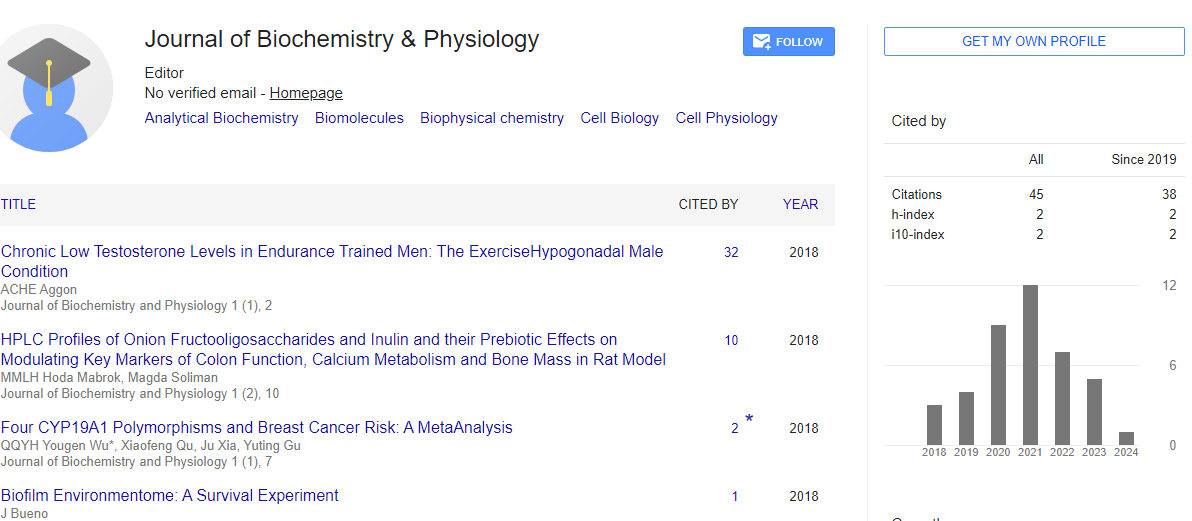Opinion Article, J Biochem Physiol Vol: 6 Issue: 1
Types and Functions of Protein Interactions
Mark Hemin*
1Department of Biology, University of Copenhagen, Copenhagen, Denmark
*Corresponding Author: Mark Hemin
Department of Biology, University of
Copenhagen, Copenhagen, Denmark;
E-mail: hemin.mark@gmail.com
Received date: 20-Feb-2023, Manuscript No. JBPY-23-93414;
Editor assigned date: 22-Feb-2023, PreQC No. JBPY-23-93414 (PQ);
Reviewed date: 09-Mar-2023, QC No JBPY-23-93414;
Revised date: 16-Mar-2023, Manuscript No. JBPY-23-93414 (R);
Published date: 23-Mar-2023, DOI: 10.4172/jbpy.1000123
Citation: Hemin M (2023) Types and Functions of Protein Interactions. J Biochem Physiol 6:1.
Description
Proteins are essential molecules that perform a wide range of functions in the body. They are involved in everything from structural support to enzyme catalysis, and they play a critical role in the regulation of cellular processes. Proteins are made up of long chains of amino acids that are folded into complex three-dimensional structures. The precise structure of a protein is critical to its function, and any changes to this structure can have significant consequences. Proteins can be classified into several categories based on their structure, including fibrous proteins, globular proteins, and membrane proteins. Fibrous proteins, such as collagen and keratin, are long, linear molecules that provide structural support to cells and tissues. They are typically insoluble in water and are highly resistant to degradation. Globular proteins, such as enzymes and antibodies are compact, spherical molecules that are soluble in water. They are typically involved in metabolic and regulatory processes and are highly specific in their interactions with other molecules.
Membrane proteins are proteins that are embedded in the lipid bilayer of cell membranes. They play an important role in cell signaling and transport, and they are involved in the regulation of a wide range of cellular processes. Proteins perform a wide range of functions in the body, including structural support, enzyme catalysis, transport, signaling, and defense structural support fibrous proteins provide structural support to cells and tissues. Collagen is the main component of connective tissue and provides strength and elasticity to skin, tendons, and ligaments. Keratin is the main structural protein in hair, nails, and the outer layer of skin.
Enzyme Catalysis many proteins act as enzymes, catalyzing chemical reactions in the body. Enzymes are critical to metabolic processes such as digestion, energy production, and DNA replication. Examples of enzymes include amylase, which breaks down carbohydrates, and lactase, which breaks down lactose in milk. Transport Proteins are involved in the transport of molecules across cell membranes and throughout the body. Hemoglobin is a protein that transports oxygen in the blood. Ion channels and transporters are membrane proteins that regulate the movement of ions across cell membranes. Signaling Proteins are involved in cell signaling, which allows cells to communicate with one another and coordinate their activities. Hormones are proteins that act as signaling molecules and regulate a wide range of physiological processes. Receptor proteins are membrane proteins that bind to signaling molecules and initiate a response within the cell. Defense proteins are involved in the immune response and provide defense against pathogens such as bacteria and viruses. Antibodies are proteins that bind to specific antigens and mark them for destruction by the immune system.
Protein interactions
Proteins interact with one another and with other molecules in a wide range of ways. Some proteins bind to specific molecules, such as enzymes that bind to substrates to catalyze chemical reactions. Other proteins interact with one another to form complexes, such as hemoglobin, which is made up of four subunits that interact with one another to bind oxygen. Protein-protein interactions are critical to many cellular processes, such as signal transduction and gene regulation. Proteins can interact with one another through a variety of mechanisms, including hydrogen bonding, electrostatic interactions, and van der Waals forces.
 Spanish
Spanish  Chinese
Chinese  Russian
Russian  German
German  French
French  Japanese
Japanese  Portuguese
Portuguese  Hindi
Hindi 